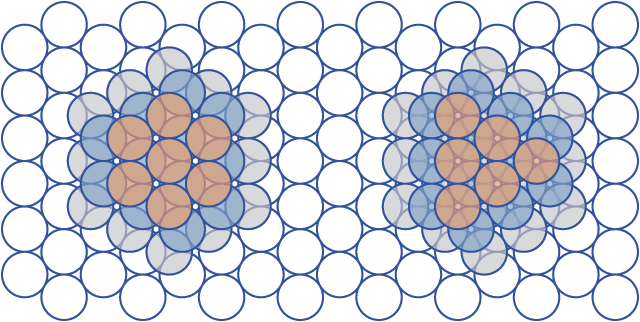I am trying to pack hard-spheres in a unit cubical box, such that these spheres cannot overlap on each other. This is being done in Python.
I am given some packing fraction f, and the number of spheres in the system is N.
So, I say that the diameter of each sphere will be
d = (p*6/(math.pi*N)**)1/3).
My box has periodic boundary conditions - which means that there is a recurring image of my box in all direction. If there is a particle who is at the edge of the box and has a portion of it going beyond the wall, it will stick out at the other side.
This is my code, with me generating a configuration array called box.
import numpy as np
import pandas as pd
import math
import matplotlib.pyplot as plt
from mpl_toolkits.mplot3d import Axes3D
np.random.seed(1)
#initialize the system
L = 1 #length of box
N = 500 #number of particles in a box
phi = np.asarray([0.2,0.45]) #packing fractions
#calculating the particle diameters so that we get the right density and packing fractions
d = (phi[1]*6/(N*math.pi))**(1/3)
#d=0.12 (approx)
rho = N/(L**3) #number density
#intitalize box
box = np.random.uniform(0,1,(N, 3))
#simulation 1
diameter = d #tolerance
#check if box is valid
#this is a collection of loops to check if the particles we have placed are
#not overlapping
#we place i = 0 particle, no problem
#then we place the other particles, and we check with all the previously placed particles if
#the placement is okay or not
for i in range(1,N):
mybool=True
print("particles in box: " + str(i))
while (mybool): #the deal with this while loop is that if we place a bad particle, we need to change its position, and restart the process of checking
for j in range(0,i):
displacement=box[j,:]-box[i,:]
for k in range(3):
if abs(displacement[k])>L/2:
displacement[k] -= L*np.sign(displacement[k])
distance = np.linalg.norm(displacement,2) #check distance between ith particle and the trailing j particles
if distance<diameter:
box[i,:] = np.random.uniform(0,1,(1,3)) #change the position of the ith particle randomly, restart the process
break
if j==i-1 and distance>diameter:
mybool = False
break
#print(np.linalg.norm(box[0,:]-box[119,:]))
#test script to check if the above generated a sound configuration worked or not
for i in range(1,N):
for j in range(0,i):
displacement=box[j,:]-box[i,:]
for k in range(3):
if abs(displacement[k])>L/2:
displacement[k] -= L*np.sign(displacement[k])
distance = np.linalg.norm(displacement,2) #check distance between ith particle and the trailing j particles
if distance<diameter:
print("this is bad")
##########
My attempt:
- Create a numpy N-by-3 array
boxwhich holds the position vector of each particle[x,y,z] - The first particle is fine as it is.
- The next particle in the array is checked with all the previous particles. If the distance between them is more than
d, move on to the next particle. If they overlap, randomly change the position vector of the particle in question. If the new position does not overlap with the previous atoms, accept it. - Repeat steps 2-3 for the next particle.
I am trying to populate my box with these hard spheres, in the following manner:
for i in range(1,N):
mybool=True
print("particles in box: " + str(i))
while (mybool): #the deal with this while loop is that if we place a bad particle, we need to change its position, and restart the process of checking
for j in range(0,i):
displacement=box[j,:]-box[i,:]
for k in range(3):
if abs(displacement[k])>L/2:
displacement[k] -= L*np.sign(displacement[k])
distance = np.linalg.norm(displacement,2) #check distance between ith particle and the trailing j particles
if distance<diameter:
box[i,:] = np.random.uniform(0,1,(1,3)) #change the position of the ith particle randomly, restart the process
break
if j==i-1 and distance>diameter:
mybool = False
break
The problem with this code is that if p=0.45, it is taking a really, really long time to converge. Is there a better method to solve this problem, more efficiently?
 And there is no need to calculate spheres in between the edges, because their perfect arrangement is known. You will have gaps on the borders of a box, even with 'poking from another side', because spheres size likely wont arrange to a perfect grid on the edge. This solution takes about the same time for any size of the box and number of spheres, because you are only checking the boundary.
And there is no need to calculate spheres in between the edges, because their perfect arrangement is known. You will have gaps on the borders of a box, even with 'poking from another side', because spheres size likely wont arrange to a perfect grid on the edge. This solution takes about the same time for any size of the box and number of spheres, because you are only checking the boundary.